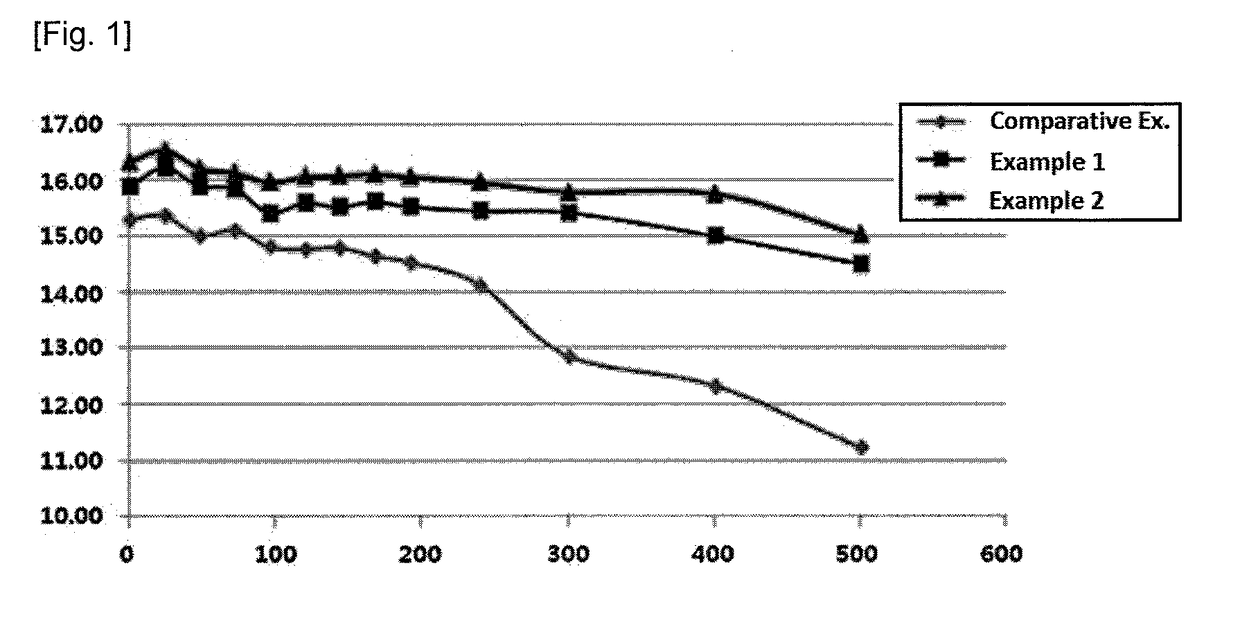Organic-inorganic hybrid perovskite compound, its preparation method and solar cell comprising the same
a technology compound, which is applied in the field of organic-inorganic hybrid perovskite compound, can solve the problems of increasing energy consumed for the purification of raw materials, affecting limiting the reduction of production costs, so as to increase the stability of solar cells, reduce the energy consumption of zero point perovskite compounds, and increase the chemical stability of perovskite compounds
- Summary
- Abstract
- Description
- Claims
- Application Information
AI Technical Summary
Benefits of technology
Problems solved by technology
Method used
Image
Examples
preparation example 1
Preparation of Methyl ammonium iodide-d5
[0056]Methyl amine-d5 gas was injected and filled into a 2 L vacuum flask. The flask was maintained for about 15 minutes until gas had condensed at −78° C. (dry ice and acetone bath) to make liquid. In the flask, 5 g of methanol-d4 was injected by a syringe and stirred for 30 minutes. Then, the temperature was raised to 0° C. Hydriodic acid (HI 57 wt %) (22.66 mL, 0.17 mol) was injected and then stirred for 1.5 hours. The solvent was removed by the rotary evaporator, washed with diethyl ether, filtered and dried in vacuum to produce methyl ammonium iodide-d5 (10.98 g, 80.4%).
[0057]2H NMR (spinning rate=18 kHz) (600 MHz, ppm): 1.1 (3, s) 5.2 (2, s)
[0058]1H NMR (D2O (700 MHz), ppm): 4.28 (1, s)
preparation example 2
Preparation of Methyl ammonium bromide-ds
[0059]Methyl ammonium bromide-d5 was prepared in the same manner as in Preparation Example 1, except that hydrobromic acid (HBr 48 wt %) was used instead of hydriodic acid (HI 57 wt%).
[0060]2H NMR (spinning rate=18 kHz) (600 MHz, ppm): 1.2 (3, s) 5.3 (2, s)
[0061]1H NMR (D2O(700 MHz), ppm): 4.30 (1, s)
preparation example 3
Preparation of Methyl ammonium chloride-d5
[0062]Methyl ammonium chloride-d5 was prepared in the same manner as in Preparation Example 1, except that hydrochloric acid (HBr 37 wt %) was used instead of hydriodic acid(HI 57 wt %).
[0063]2H NMR (spinning rate=18 kHz) (600 MHz, ppm): 1.2 (3, s) 5.4 (2, s)
[0064]1H NMR (D2O(700 MHz), ppm): 4.31 (1, s)
PUM
| Property | Measurement | Unit |
|---|---|---|
| distance | aaaaa | aaaaa |
| electrical energy | aaaaa | aaaaa |
| current-voltage | aaaaa | aaaaa |
Abstract
Description
Claims
Application Information
 Login to View More
Login to View More - R&D
- Intellectual Property
- Life Sciences
- Materials
- Tech Scout
- Unparalleled Data Quality
- Higher Quality Content
- 60% Fewer Hallucinations
Browse by: Latest US Patents, China's latest patents, Technical Efficacy Thesaurus, Application Domain, Technology Topic, Popular Technical Reports.
© 2025 PatSnap. All rights reserved.Legal|Privacy policy|Modern Slavery Act Transparency Statement|Sitemap|About US| Contact US: help@patsnap.com

